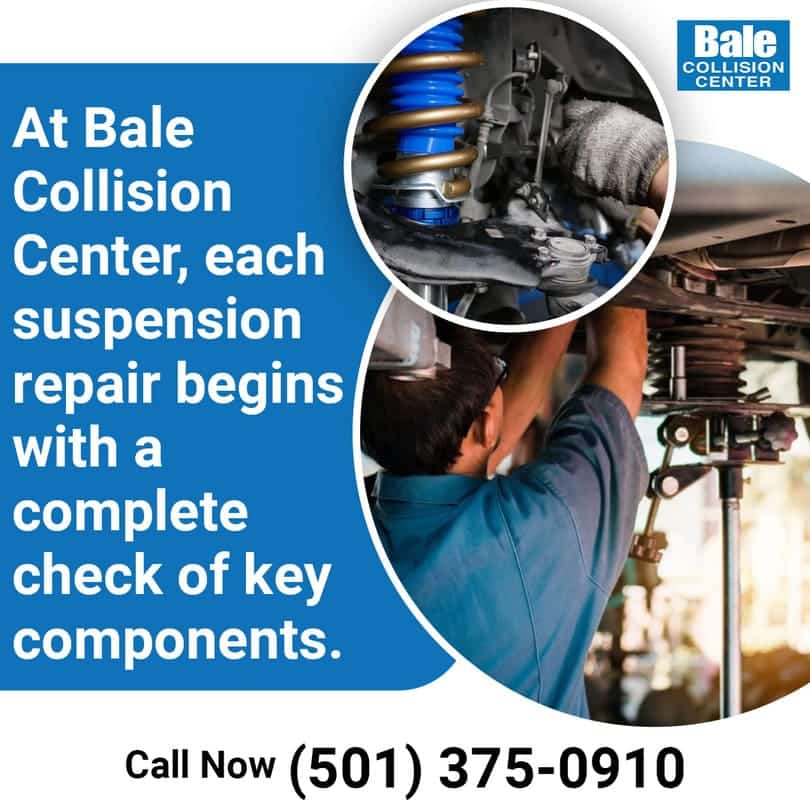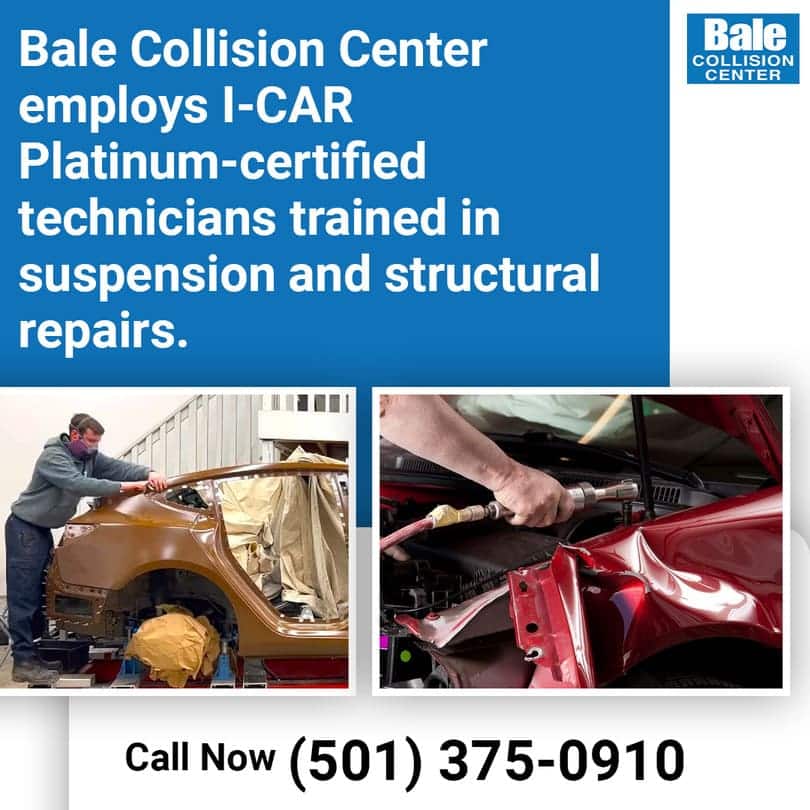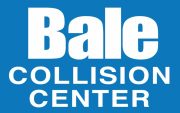Suspension damage is common after a car accident, especially in front-end or side collisions. Even minor impacts can affect how your vehicle handles, steers, and rides. In addition to poor alignment and uneven tire wear, a damaged suspension system can also make it harder to retain control at higher speeds. That’s why it’s important to have it inspected and repaired at a qualified auto body shop near you.
At Bale Collision Center (Downtown), we help drivers in Little Rock identify and repair suspension problems caused by collisions. We use factory-approved repair methods and advanced diagnostic tools to make sure your vehicle drives the way it should. This article explains how we approach suspension repairs at our auto body shop in Little Rock, AR. We’ll walk you through the signs of suspension damage and how we can help you with it.

Suspension Damage After a Collision
Suspension problems often show up after front, rear, or side collisions, even at speeds under 25 mph. These impacts can bend control arms, shift alignment angles, or damage struts and shocks. Even curb hits during an accident can knock suspension parts out of place.
Why Suspension Matters to Vehicle Performance
A damaged suspension affects how your car steers, brakes, and handles bumps. If the damage is left unchecked, it can result in faster tire wear, reduced control, and poor fuel efficiency.
When components like tie rods, ball joints, or bushings shift out of position, your wheels may no longer stay aligned. That puts stress on other parts and affects how the car behaves on the road. At Bale Collision Center, we check for steering drift, nose-diving during braking, and uneven ride height, as all these signs indicate that something deeper is wrong.
Common Accident Scenarios That Affect Suspension Systems
Frontal impacts, side collisions, and undercarriage hits are the most likely to damage suspension parts. Here are examples of how different crashes affect the system:
Front-end collisions: These can damage struts, steering knuckles, and lower control arms.
Side-impact crashes: These often bend trailing arms or displace the subframe.
Hitting curbs or potholes: This can throw off wheel alignment or damage coil springs.
At Bale Collision Center, our team inspects for visible damage and hidden misalignments using measuring systems and visual cues. Even if your car looks fine after a minor crash, we check for hard-to-spot issues that could affect long-term safety.
Components Most Commonly Affected
Accidents often damage core suspension parts that control movement, ride quality, and alignment. At Bale Collision Center, we inspect each of these during post-collision repairs to restore safe handling and balance. Suspension parts work together to absorb impact, keep the wheels in contact with the road, and support steering. When one component is bent or worn, it affects the entire system.
Control Arms and Ball Joints
Control arms and ball joints connect the suspension to the frame and allow the wheels to move up and down. They’re prone to bending or breaking in side and front-end collisions.
If these parts are misaligned or worn out, drivers may notice pulling, steering instability, or uneven tire wear. At our auto body shop in Little Rock, AR, we use digital alignment systems to detect signs of control arm or ball joint damage and frame gauges to check for structural shifts that may affect suspension mounting points.
Shocks and Struts
Shocks and struts absorb road impact and stabilize your vehicle during braking or cornering. Front or rear collisions can damage these components, especially if the car hits another object directly.
Symptoms of worn or broken shocks and struts include bouncing after hitting a bump, nose-diving when braking, and loss of control on rough roads. Struts are also a structural part of the front suspension, so any damage can affect alignment angles. We check strut towers for cracks or misalignment at our auto body repair shop and test each shock for fluid leaks and performance loss.
Springs and Bushings
Springs support the vehicle’s weight and absorb road shock. Bushings cushion joints and reduce friction. Both wear down faster after a crash or when suspension angles shift.
At Bale Collision Center, we often replace coil springs that have cracked, collapsed, or shifted out of position. Bushings, especially those made of rubber, can tear or deform under stress. Damaged bushings can cause clunking noises and poor handling.
Springs and bushings don’t always show visible damage, so our auto body repair shop relies on ride height measurements, noise checks, and bushing play tests to diagnose them.
Sway Bars and Links
Sway bars and their connecting links reduce body roll when turning. These are lightweight components that bend or snap easily during a side or corner impact.
When sway bar links break, the vehicle may feel unstable during turns, and passengers may notice more body roll or noise from the suspension. Sway bars also affect traction, especially during sharp turns or emergency maneuvers.
At Bale Collision Center, we replace broken or bent sway bar links as part of our suspension repair services. They’re small but essential for keeping your vehicle balanced during everyday driving.
Signs Your Suspension May Be Damaged After a Collision
Even a minor accident can knock suspension parts out of alignment or damage key components. At Bale Collision Center, we help drivers spot early warning signs that their suspension may need attention after a crash.
Warning Symptoms Drivers Shouldn’t Ignore
Common signs of suspension trouble include the vehicle pulling to one side, uneven tire wear, or a rough, unstable ride. If your vehicle starts drifting left or right without turning the wheel, the alignment may be off. Unusual tire wear, such as scalloped edges or bald spots, often points to bent control arms or misaligned struts. You might also notice:
- Excess bouncing after hitting bumps
- A nose-dive effect when braking
- Clunking or knocking sounds
- One corner of the vehicle sitting lower
Each of these symptoms can indicate problems with shocks, springs, joints, or bushings. Drivers who spot these warning signs after a crash should contact an auto body shop near you for a full suspension system inspection.
How Suspension Problems Affect Handling and Safety
Damaged suspension affects steering response, braking stability, and tire grip. The suspension keeps all four tires in contact with the road. When it’s out of balance, the vehicle may become harder to control, especially during sudden stops or turns. That increases stopping distances and the risk of losing control.
A faulty suspension can also trigger safety system issues. For example, many modern vehicles rely on accurate ride height for sensors used in adaptive braking and stability control. If the suspension is off, those systems may not respond correctly.
Importance of Timely Repairs
Addressing suspension damage right after a collision protects your vehicle’s performance, safety, and value. At Bale Collision Center, we inspect suspension systems thoroughly to prevent future issues and keep your vehicle driving as it should.
Driving Safety and Control
Even small alignment issues can impact how well your vehicle handles in emergency situations. A vehicle that pulls to one side, feels loose in corners, or bounces excessively is harder to control. This increases the chance of accidents, especially in wet or uneven road conditions. Timely repairs restore stability, reduce swaying, and improve overall ride control.
Avoiding Long-Term Tire and Brake Issues
If the suspension isn’t distributing weight evenly, tires wear down unevenly. That shortens tire life and increases replacement costs.It also puts more stress on brake components like calipers and rotors.
For example, a bad strut can cause nose-diving during braking, which adds extra load to the front brakes and causes premature wear. By fixing suspension problems early, you reduce the risk of tire blowouts and extend the life of your brake system.
Preserving the Vehicle’s Structural Integrity
When parts like control arms or bushings are compromised, they can transfer impact forces to other sections of the vehicle. That may result in cracks, weakened mounts, or misalignment of structural components.
Unrepaired suspension issues may also prevent proper airbag deployment if sensors are affected, especially in vehicles with active safety systems. At our auto body shop in Little Rock, AR, we check for hidden structural damage and suspension wear to help protect your vehicle’s long-term durability.
Why Delaying Repairs Can Lead to Higher Costs
Waiting to fix suspension damage can lead to more expensive repairs and faster tire wear. For example, ignoring a worn ball joint can lead to control arm damage or steering issues. Damaged shocks or struts will wear out tires faster and reduce fuel efficiency.
Steering and suspension problems are the third‑most common cause of mechanical failure linked to crashes. Blown tires or worn brakes are easy to spot, but damage to the suspension caused by wear and tear is harder to identify post-crash. Identifying and addressing these issues early keeps your vehicle safer and avoids bigger bills later.
If you’ve been in a collision and notice symptoms like pulling, uneven tire wear, or poor handling, schedule an inspection at an auto body shop near you.
What to Expect from Suspension Repairs at Bale Collision Center in Little Rock, AR
At Bale Collision Center, we handle suspension repairs using factory procedures, skilled technicians, and advanced equipment. We follow approved repair plans that restore your vehicle’s safety and performance.
Tools and Capabilities Required for Suspension Repair
Suspension repair requires frame measurement systems, alignment machines, and OEM-specific tools. Our team uses computerized alignment machines to check for misalignment in camber, caster, and toe angles. We also rely on digital frame gauges to detect shifts in the unibody structure.
For example, a bent control arm might seem minor, but if it affects ride height or tire angles, it needs precise replacement and recalibration. We work with manufacturer repair procedures to match original performance.
Our auto body repair shop uses OEM or equivalent-grade parts for long-term reliability, and every repair is tested for correct steering response and suspension geometry.

Role of I-CAR Platinum Certified Technicians in Ensuring Repair Accuracy
Our I-CAR Platinum-certified technicians follow industry-approved methods to restore safety and handling. I-CAR certification means our team has completed advanced training in structural and suspension repairs. This prevents misdiagnoses or missed damage that could cause trouble down the road. For example, a damaged strut tower may require frame correction. If not done right, it may cause the suspension to wear out faster or affect alignment.
You can trust that every technician handling your vehicle at our auto body repair shop understands what to check, how to correct it, and what documentation is required to meet safety standards.
Insurance Claims and Documentation Support
We work with all major insurers and help document collision-related suspension damage accurately. After a crash, many suspension problems aren’t visible at first glance. We provide detailed inspections, photos, and alignment reports to support your insurance claim.
This ensures that parts like shocks, control arms, and bushings, which are often excluded in early estimates, are correctly identified and covered when eligible. We also assist with direct communication with adjusters to reduce delays.
If you’re searching for an auto body shop near you that knows how to handle suspension problems after an accident, Bale Collision Center is ready to assist.
Schedule a Post-Accident Suspension Evaluation
If your vehicle doesn’t handle the same after a crash, it’s time to have the suspension checked. Even minor impacts can damage parts like control arms, struts, or bushings, leading to poor steering, uneven tire wear, or alignment issues.
At Bale Collision Center in Little Rock, AR, we use factory-approved repair methods and certified technicians to evaluate and fix these problems accurately. We also work directly with insurance providers to document damage and speed up the claims process.
If you’ve been in an accident and suspect suspension damage, contact Bale Collision Center at (501) 375-0910 or bccdowntown@baleautomotive.comfor a thorough evaluation and reliable repairs. I-CAR Platinum Certified technicians at our auto body shop in Little Rock, AR, are ready to help you get back on the road with confidence.
